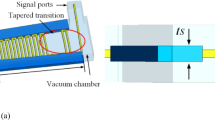Abstract
This paper describes the design of tip loss profile on support rod for a high gain, high efficiency helix TWT. The tip loss profile at sever ends for the input and the output section of the helix slow wave structure has been designed for return loss at severs ends better than -20 dB. The experimental results have been carried out in the input and the output section of the helix assemblies for the high gain helix TWT to find the return loss in the region of carbon coated tip loss on the support rods. The experimental result has been compared with the simulated performance for the return loss at the sever ends. The design of tip loss profile on the support rod for helix TWT has been carried out in real situation using Ansoft HFSS. A good agreement has been found in the simulated and experimental results.







Similar content being viewed by others
References
A. S. Gilmour Jr., Principles of Traveling Wave Tube. Artech House, Boston, London, (1994).
M. K. Alaria, A. Bera, A. K. Sinha, and V. Srivastava, “Analysis of helix SWS for high efficiency space TWT,”. Int. J. Infrared Millim. & Terahertz waves 30, 211–216 (2009).
S. O. Wallander, “Reflections and gain ripple in TWT’s,”. IEEE Trans. Electronics devices 19, 655–660 (1972).
C. E. Hobrecht, “Resonant Loss for Helix TWT,” Proceedings of International Electron Device Meeting, 348–350 1977
D. M. Goebel, J. G. Keller, W. Menninger, and S. T. Blunk, “Gain Stability of a TWT,”. IEEE Trans. Electronics devices 46, 2235–2243 (1999).
Ansoft HFSS, 3-D electromagnetic Simulation Software. Ansoft corp., Pittsburgh, PA
D. K. Ghodgaonkar, V.V. Varadan, and V.K. Varadan, “A free space method for measurement of dielectric constant and loss tangent at microwave frequency,”. IEEE Trans Instrum Meas 38, 789–793 (1989).
Vikas Kumar, M K Alaria, Anil Vohra and V Srivastava, “Carbon-coating on helix TWT support rods and its a characterization,” APMC-2004, New Delhi.
Acknowledgments
This work was carried out under a sponsored project from ISRO, Bangalore. The authors are thankful to the Director, CEERI, Pilani and Dr. SN Joshi, Dr. RK Sharma, Microwave Tubes Area. The authors are also thankful to Dr. S Ghosh, BEL, Bangalore for all their support and guidance and all other project team members for their support.
Author information
Authors and Affiliations
Corresponding author
Rights and permissions
About this article
Cite this article
Alaria, M.K., Sinha, A.K. & Srivastava, V. Design of Tip Loss Profile on Support Rod for a Helix TWT. J Infrared Milli Terahz Waves 30, 651–656 (2009). https://doi.org/10.1007/s10762-009-9502-x
Received:
Accepted:
Published:
Issue Date:
DOI: https://doi.org/10.1007/s10762-009-9502-x




